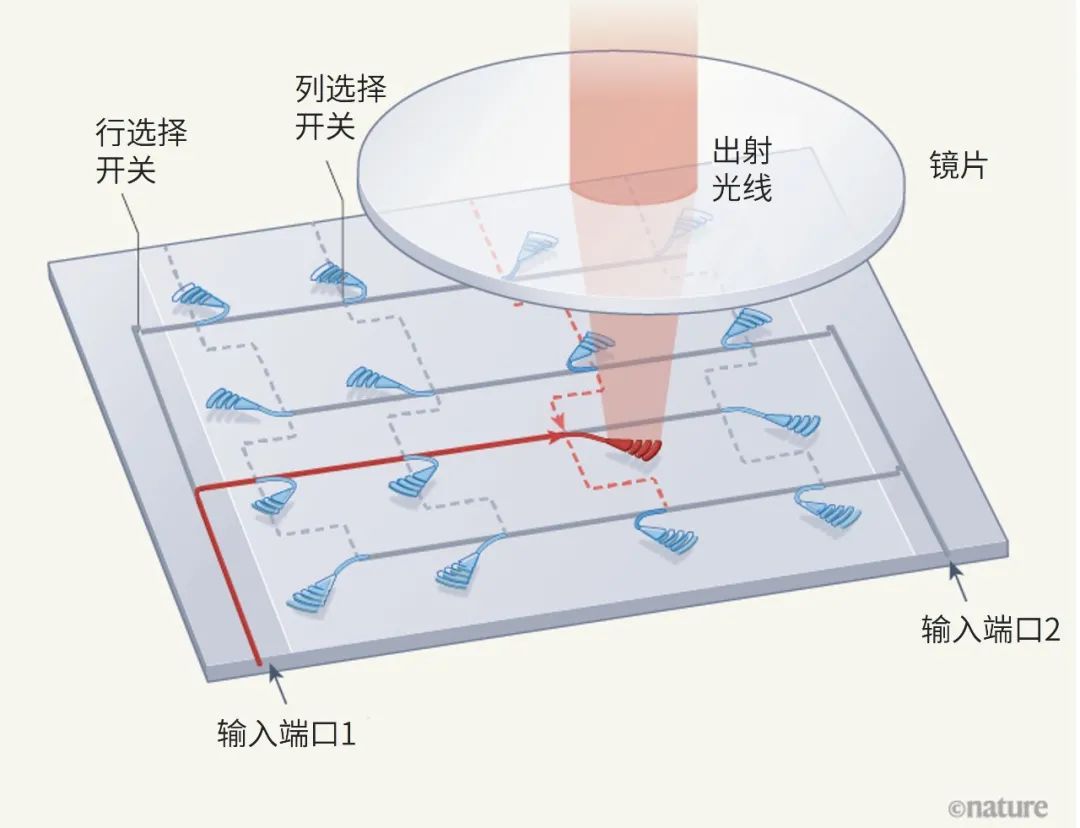
Original authors: H. Y. Fu & Qian Li
A novel optical device can achieve high-speed, high-resolution ranging over a large field of view. Its clever switch circuit design realizes compact packaging and low power consumption.
The human eye perceives the surrounding environment through 3D information, yet imaging systems that can match the perceptual capabilities of the human eye are rare. Optical detection and ranging systems (LiDAR) stand out: this system utilizes 3D imaging to measure distant targets with high precision, making it prevalent in a range of technological applications from autonomous driving to complex surveying [1]. The next challenge for LiDAR technology is miniaturization and single-chip integration. However, the cost of small size and high integration is limited field of view and low resolution. Recently, a paper published by Zhang et al. in Nature [2] demonstrated an integrated LiDAR system that provides excellent field of view and high resolution on a compact, low-power device.
Light in LiDAR plays a role similar to radio waves in traditional radar: LiDAR sensors send and receive signals encoded in light pulses, which the system then uses to map the surrounding environment. To obtain 3D map information, a laser beam must scan the space, which typically requires a mechanical laser scanner with moving parts. Such devices often suffer from poor stability, slow speed, bulkiness, and high costs. Over the past decade, faster and more stable non-mechanical devices have begun to replace mechanical laser scanners [3,4]. Optical phased arrays and focal plane switch arrays are two such devices.
Optical phased arrays work by modulating the optical characteristics of light waves emitted by a set of array antennas—specifically, the relative phase of the light waves, which is the degree of synchronization between waves. To improve performance, it requires large-sized antennas densely packed on a single chip. However, controlling the phases of numerous closely arranged components is challenging, and high power consumption makes system integration difficult. Although individual high-resolution, large field of view 2D optical phased arrays have been reported [5], the field of view angles of most 2D optical phased arrays only reach 46° and 36° in the vertical directions [6].
In contrast, focal plane switch arrays map every angle in the field of view to pixels in the lens’s focal plane, imaging like a camera. Focal plane switch arrays do not control the phase of each pixel but use switches to turn each pixel on and off. The optical antennas corresponding to each pixel are independent of other antennas, allowing for the integration of large-scale arrays on a single chip. Nevertheless, due to the size of the switches and the energy required to control them, focal plane switch arrays still have high power consumption and are not small in packaging size [7].
For these reasons, integrating large-scale focal plane switch arrays onto a single chip is a challenging task, but Zhang et al. successfully installed an antenna array equivalent to 128×128 pixels on a fingertip-sized chip measuring only 10×11 mm. This means that when equipped with a large aperture lens, their device can scan 16,384 different directions within a 70° field of view by switching different antennas to excite the light beam.
Their chip achieves this remarkable performance with the help of micro-electromechanical silicon photonic switches controlling the optical antennas. The key lies in the careful design of these switches, which can achieve microsecond-level response times. The chip also benefits from an innovative waveguide system that reduces the required number of switches. Each column of the array establishes circuit connections through one of the waveguides, allowing specific antennas to be activated by selecting appropriate row and column switches without the need for individual switches at each antenna (Figure 1). Light is sent to the designated antenna from one of the two input ports and then emitted at the angle set by that antenna. When the switch is off, the loss is almost zero, thereby reducing power consumption, even when fabricating large-scale arrays.

Figure 1 | Integrated LiDAR system. The optical detection and ranging (LiDAR) system designed by Zhang et al. [2] achieves high-resolution, large field of view ranging while maintaining compact packaging and low power consumption. The system consists of an array of 128×128 optical antennas (the figure shows a partial 4×4 array). By controlling micro-electromechanical switches, light input from one of the two input ports (red arrow) is routed through the specified row and column pathways to each antenna. There are circuit connections between the optical antennas in the same column (dashed lines in the figure) to reduce the number of switches. The light emitted by the antennas forms a laser beam directed towards 16,384 different directions, enabling ranging within a 70° field of view. (Adapted from reference 2, Figure 1)
The LiDAR system developed by Zhang et al. shows great potential, particularly highlighted by its massive pixel count and large field of view. Combined with a frequency-tunable continuous output light source, this system can easily capture high-resolution 3D images. It can detect distances with a resolution of 1.7 cm, which matches well with the frequency range of the laser they used, demonstrating the feasibility of this LiDAR system in practical applications. By selecting lenses of different focal lengths, fields of view, and lateral resolutions (the ability to distinguish between two adjacent points in the field of view), the system has the opportunity to adapt to different application scenarios, showcasing the flexibility of this solution.
However, the currently measured lateral resolution is only 0.13°, which is relatively low. This will limit the usability of this technology in long-distance detection, a common limitation for most systems using focal plane switch arrays. Increasing the chip size or reducing the footprint of each pixel can improve resolution, which requires further optimization of switch design.
Nevertheless, the system developed by Zhang et al. may bring technological breakthroughs for integrated LiDAR systems. With the maturation of processing technology, further miniaturization, and performance enhancement, focal plane switch arrays will have great potential in applications such as million-pixel 3D LiDAR and optical communication.
References:
1. Schwarz, B. Nature Photon.4, 429–430 (2010).
2. Zhang, X., Kwon, K., Henriksson, J., Luo, J. & Wu, M. C. Nature 603, 253–258 (2022).
3. Jiang, Y., Karpf, S. & Jalali, B. Nature Photon. 14, 14–18 (2020).
4. Li, Z., Zang, Z., Han, Y., Wu, L. & Fu, H. Y. Opt. Express 29, 16547–16562 (2021).
5. Poulton, C. V. et al. Opt. Lett. 42, 4091–4094 (2017).
6. Sun, J., Timurdogan, E., Yaacobi, A., Hosseini, E. S. & Watts, M. R. Nature 493, 195–199 (2013).
7. Rogers, C. et al. Nature 590, 256–261 (2021).
The original article titled Light arrays measure up on a chip the size of a fingertip was published on March 9, 2022, in the news and views section of Nature.
© nature
doi: 10.1038/d41586-022-00642-1
Click to read the original article in English
Promotion | Recruiting Talents Global Recruitment at Tsinghua University Shenzhen International Graduate School 2023

>> Click the image to view the original tweet <<
Copyright Statement:
This article was translated by the Springer Nature Shanghai office. The Chinese content is for reference only; all content is subject to the English original. Feel free to forward to your friends, and for reprints, please email [email protected]. Unauthorized translations are considered infringement, and the copyright holder reserves the right to pursue legal responsibility.
© 2023 Springer Nature Limited. All Rights Reserved
Star us 🌟, remember to like, view + and share!